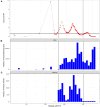Factors related to human-vector contact that modify the likelihood of malaria transmission during a contained Plasmodium falciparum outbreak in Praia, Cabo Verde
- PMID: 38455281
- PMCID: PMC10910924
- DOI: 10.3389/fepid.2022.1031230
Factors related to human-vector contact that modify the likelihood of malaria transmission during a contained Plasmodium falciparum outbreak in Praia, Cabo Verde
Abstract
Background: Determining the reproductive rate and how it varies over time and space (RT) provides important insight to understand transmission of a given disease and inform optimal strategies for controlling or eliminating it. Estimating RT for malaria is difficult partly due to the widespread use of interventions and immunity to disease masking incident infections. A malaria outbreak in Praia, Cabo Verde in 2017 provided a unique opportunity to estimate RT directly, providing a proxy for the intensity of vector-human contact and measure the impact of vector control measures.
Methods: Out of 442 confirmed malaria cases reported in 2017 in Praia, 321 (73%) were geolocated and informed this analysis. RT was calculated using the joint likelihood of transmission between two cases, based on the time (serial interval) and physical distance (spatial interval) between them. Log-linear regression was used to estimate factors associated with changes in RT, including the impact of vector control interventions. A geostatistical model was developed to highlight areas receptive to transmission where vector control activities could be focused in future to prevent or interrupt transmission.
Results: The RT from individual cases ranged between 0 and 11 with a median serial- and spatial-interval of 34 days [interquartile range (IQR): 17-52] and 1,347 m (IQR: 832-1,985 m), respectively. The number of households receiving indoor residual spraying (IRS) 4 weeks prior was associated with a reduction in RT by 0.84 [95% confidence interval (CI) 0.80-0.89; p-value <0.001] in the peak-and post-epidemic compared to the pre-epidemic period.
Conclusions: Identifying the effect of reduced human-vector contact through IRS is essential to determining optimal intervention strategies that modify the likelihood of malaria transmission and can inform optimal intervention strategies to accelerate time to elimination. The distance within which two cases are plausibly linked is important for the potential scale of any reactive interventions as well as classifying infections as imported or introduced and confirming malaria elimination.
Keywords: Cabo Verde; malaria; reproductive number; transmission heterogeneity; transmission reduction.
Copyright © 2022 Stresman, DePina, Nelli, Monteiro, Leal, Moreira, Furtado, Roka, Neatherlin, Gomes, Tfeil and Lindblade.
Conflict of interest statement
The authors declare that the research was conducted in the absence of any commercial or financial relationships that could be construed as a potential conflict of interest.
Figures



Similar articles
-
Spatiotemporal characterisation and risk factor analysis of malaria outbreak in Cabo Verde in 2017.Trop Med Health. 2019 Jan 7;47:3. doi: 10.1186/s41182-018-0127-4. eCollection 2019. Trop Med Health. 2019. PMID: 30636920 Free PMC article.
-
Updates on malaria epidemiology and profile in Cabo Verde from 2010 to 2019: the goal of elimination.Malar J. 2020 Oct 23;19(1):380. doi: 10.1186/s12936-020-03455-7. Malar J. 2020. PMID: 33097051 Free PMC article.
-
Folic acid supplementation and malaria susceptibility and severity among people taking antifolate antimalarial drugs in endemic areas.Cochrane Database Syst Rev. 2022 Feb 1;2(2022):CD014217. doi: 10.1002/14651858.CD014217. Cochrane Database Syst Rev. 2022. PMID: 36321557 Free PMC article.
-
Imported malaria in Cabo Verde (2010-2024): Risks to post-elimination stability.PLOS Glob Public Health. 2025 Jun 12;5(6):e0004592. doi: 10.1371/journal.pgph.0004592. eCollection 2025. PLOS Glob Public Health. 2025. PMID: 40504790 Free PMC article.
-
Malaria epidemiology and interventions in Ethiopia from 2001 to 2016.Infect Dis Poverty. 2018 Nov 5;7(1):103. doi: 10.1186/s40249-018-0487-3. Infect Dis Poverty. 2018. PMID: 30392470 Free PMC article. Review.
References
-
- Nishiura H, Chowell G. The effective reproduction number as a prelude to statistical estimation of time-dependent epidemic trends. In: Castillo-Chavez C, Chowell G, Hayman JM, Bettencourt LMA, editors. Mathematical and Statistical Estimation Approaches in Epidemiology. Dordrecht: Springer Netherlands; (2009), p. 102–21. 10.1007/978-90-481-2313-1_5 - DOI
Grants and funding
LinkOut - more resources
Full Text Sources

